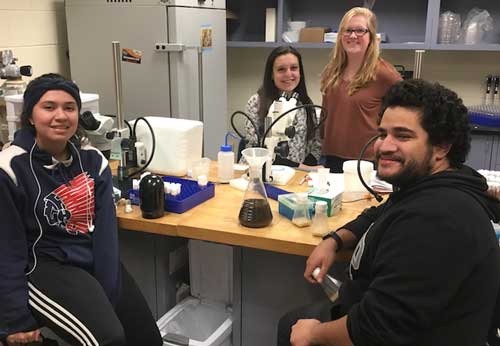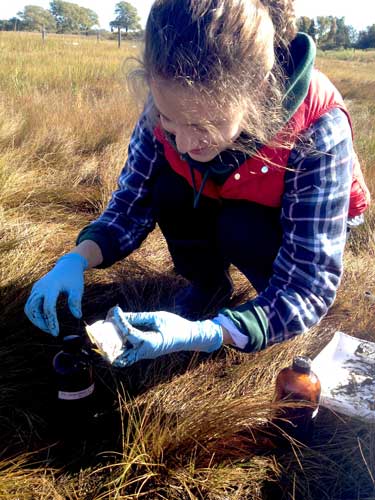Research Opportunities in Biology
General information and list of research labs
(in alpha order by professor's last name)
Undergraduate and
graduate RIC students in Biology can learn and practice research skills in a variety of biological areas of study, either in lab or natural field setting (or both), in the laboratories listed below (some labs also provide research opportunities for students majoring in other departments and programs such as
Environmental Studies,
Physical sciences,
Computer Science, or
Education;
check with the individual professor). Instructor approval is necessary before the student can register for any research course. After you have reviewed the list of research labs below, please contact the professor responsible for the lab that interests you directly using the email address provided.
 After you have been accepted into a research lab, the
Application for Independent Research form must be filled out and submitted by November 15th if the research project is to be undertaken in the spring, and by April 15th if the project is to be undertaken in the summer or fall. Ask for that form at the main Biology Office (252 Fogarty), or from your research mentor.
After you have been accepted into a research lab, the
Application for Independent Research form must be filled out and submitted by November 15th if the research project is to be undertaken in the spring, and by April 15th if the project is to be undertaken in the summer or fall. Ask for that form at the main Biology Office (252 Fogarty), or from your research mentor.
Research may be undertaken at either the undergraduate or the graduate level. Undergraduates may register for up to four credits per semester in Biology 491-494: Research in Biology. Up to four credits are allowed for a standard degree, while up to six credits are allowed for students eligible for Department Honors. Graduate students may register for up to six credits per semester for a total of six credits per degree in Biology 691-696: Directed Research. In addition, some faculty have funds to pay student researchers. In this case, the student cannot register for credit.
Your research experience can also count towards departmental Honors in Biology. Please consult the
Honors in Biology page for more information.
Britt, Deborah – All organisms, from tiny microbes to humans, have DNA damage response proteins that detect problems and repair DNA. In the
Britt Lab, students are looking at the DNA damage response in budding yeast,
Saccharomyces cerevisiae, to characterize the role of a protein known as Bcp1. The
Britt Lab works with yeast that have mutations in various DNA damage response genes, and studies the effects in combination with Bcp1. Working with yeast provides clues to what happens in other types of cells, including humans, and may eventually help us understand diseases like cancer, that involve DNA damage. Info at
dbritt@ric.edu.
de Gouvenain, Roland – In the
Forest Ecology Lab, students conduct research on the effects of human impacts (such as clear-cutting, forest fragmentation, and soil deterioration) on the ecology of southern New England forests. Changes in light and soil moisture levels can affect the growth and mortality of seedlings and adult trees, and alter the species composition of the impacted forest. The
Forest Ecology Lab provides field and/or lab research opportunities to undergraduate students willing to do research outdoors and to commute approx. 1¼ hour to field site/back. The field site is the
Yale-Myers Experimental Forest in NE Connecticut. Info at
http://www.ric.edu/faculty/rdegouvenain/ or at
rdegouvenain@ric.edu.
Hewins, Daniel – The focus of the
Hewins Lab is ecosystem Ecology and Biogeochemistry, and how drivers of carbon and nutrient cycling are affected by disturbances such as land use change, plant community change and climate change. Students in the
Hewins Lab measure litter decomposition and extracellular enzyme activity along with environmental parameters to link disturbance to process at the ecosystem scale. Additionally, the
Hewins Lab is interested in using empirical data to inform models that aim to predict future climate and its associate feedback on the rates of biogeochemical cycling. Info at
dhewins@ric.edu.
Holmes, William – The focus of the
Holmes Lab is protein folding and understanding the effects of post-translational modification on protein activity, aggregation, and cellular toxicity. Info at
wholmes@ric.edu.
Kolibachuk, Dana – The focus of the
Kolibachuk Lab is a bioluminescent marine bacterium that also produces polyhydroxyalkanoic acid or PHA. PHA is a carbon and energy reserve, similar to animal fat, that can be utilized by the cells when they are starved for nutrients. PHA has similar properties to petroleum-based plastics, yet is biodegradable and relatively nontoxic. This opens up many potential applications for this material. The
Kolibachuk Lab is interested in the molecular mechanisms behind PHA accumulation as well as the mechanisms for gene expression in the marine bacterium. Info at
dkolibachuk@ric.edu.
Maia, Anabela – Research in the Maia lab focuses on fish biomechanics. We use functional morphology to elucidate the evolution of locomotion mechanics and to understand how habitat changes can impact fishes. Our lab studies are complemented with field work to bridge the gap between biomechanics and ecology. We are also interested in the role of body shape, fins and other control surfaces during unsteady locomotion and possible application to bioinspired solutions. Some of the techniques used in my lab are respirometry, kinematics, particle image velocimetry and electromyography. Info at aresendedamaia@ric.edu
Merson, Rebeka – The focus of the
Merson Lab is the evolution of molecular responses to chemical stress in aquatic vertebrates and the mechanisms of developmental toxicity of environmental pollutants through ligand-activated transcription factors. Info at
rmerson@ric.edu.
 Patterson, Larissa – Whether it's the stripes of a tiger or the vibrant colors of poison dart frogs, pigment patterns are among the most striking and diverse animal traits. Using live-cell imaging and mutational analysis, the
Patterson Lab seeks to identify genes and cellular behaviors required for stripe formation in larval zebrafish. Undergraduate students with interests in cell biology, genetics or developmental biology are welcome to apply. Info at
lpatterson@ric.edu.
Patterson, Larissa – Whether it's the stripes of a tiger or the vibrant colors of poison dart frogs, pigment patterns are among the most striking and diverse animal traits. Using live-cell imaging and mutational analysis, the
Patterson Lab seeks to identify genes and cellular behaviors required for stripe formation in larval zebrafish. Undergraduate students with interests in cell biology, genetics or developmental biology are welcome to apply. Info at
lpatterson@ric.edu.
Roberts, Eric – The
Roberts Lab studies the cellular, molecular, and evolutionary biology of plant cell walls and polysaccharide biosynthesis. In the moss
Physcomitrella patens the lab has examined the formation of the plant cuticle, a thin waterproof wall covering that helps reduce desiccation in the aerial portions of plants, and the synthesis of cellulose, the major structural polysaccharide in plant cell walls. More recently, The
Roberts Lab has been investigating the genes involved in cell wall synthesis in the marine green alga
Derbesia tenuissima. The cell wall of this species contains a number of unusual structural polysaccharides that may help us to understand new aspects of wall biosynthesis. The lab also has an interest in microbial exopolysaccharide synthesis, such as the formation of mixed-linkage glucan in the Gram-positive bacterium
Sarcina ventriculi. Info at
eroberts@ric.edu.
Stilwell, Geoff – More than 6 million people suffer from a neurodegenerative disease (ND) for which there is no cure. The
Stilwell Lab uses the powerful genetic model organism
Drosophila melanogaster to study the consequences of mutations which cause various NDs, focusing on how mutations in the superoxide dismutase gene cause motor neuron cell death as a model of Amyotrophic Lateral Sclerosis (ALS). Mutations in superoxide dismutase were first discovered in the early 1990's and we still do not understand how changes in this one gene cause only certain cells to degenerate. The
Stilwell Lab uses genetic engineering to create fly models which replicate many features of the human disease, and uses genetic screening approaches to identify the molecular pathways leading to motor neuron death. Info at
gstilwell@ric.edu.
Toorie, Anika – The Toorie lab focuses on identifying neural and endocrine mechanisms that are disrupted under conditions of metabolic stress induced by exposure to obesogenic diets or substances of abuse. Our lab examines the reward and homeostatic centers in the rodent brain to identify unique molecular targets associated with the development or progression of metabolic syndrome and substance abuse liability. Info at atoorie@ric.edu.

